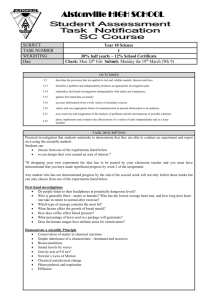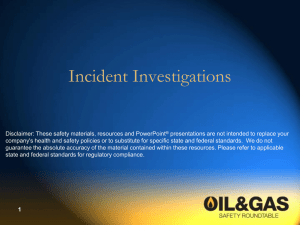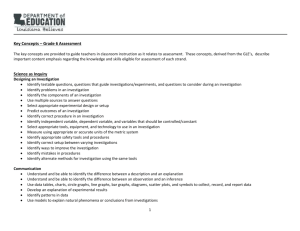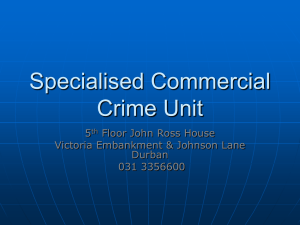Workplace Harassment & Investigations
advertisement
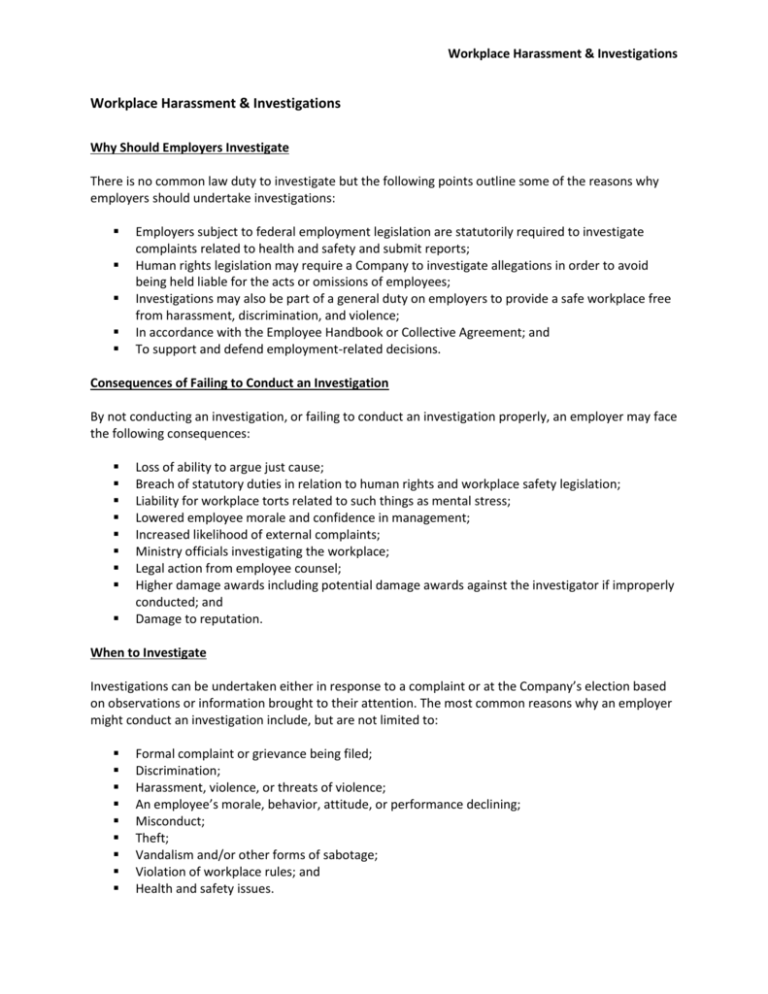
Workplace Harassment & Investigations Workplace Harassment & Investigations Why Should Employers Investigate There is no common law duty to investigate but the following points outline some of the reasons why employers should undertake investigations: Employers subject to federal employment legislation are statutorily required to investigate complaints related to health and safety and submit reports; Human rights legislation may require a Company to investigate allegations in order to avoid being held liable for the acts or omissions of employees; Investigations may also be part of a general duty on employers to provide a safe workplace free from harassment, discrimination, and violence; In accordance with the Employee Handbook or Collective Agreement; and To support and defend employment-related decisions. Consequences of Failing to Conduct an Investigation By not conducting an investigation, or failing to conduct an investigation properly, an employer may face the following consequences: Loss of ability to argue just cause; Breach of statutory duties in relation to human rights and workplace safety legislation; Liability for workplace torts related to such things as mental stress; Lowered employee morale and confidence in management; Increased likelihood of external complaints; Ministry officials investigating the workplace; Legal action from employee counsel; Higher damage awards including potential damage awards against the investigator if improperly conducted; and Damage to reputation. When to Investigate Investigations can be undertaken either in response to a complaint or at the Company’s election based on observations or information brought to their attention. The most common reasons why an employer might conduct an investigation include, but are not limited to: Formal complaint or grievance being filed; Discrimination; Harassment, violence, or threats of violence; An employee’s morale, behavior, attitude, or performance declining; Misconduct; Theft; Vandalism and/or other forms of sabotage; Violation of workplace rules; and Health and safety issues. Workplace Harassment & Investigations Goals of the Investigation Employers conduct investigations to achieve the following: To determine whether misconduct has occurred; Identify (or exonerate) specific employees who are suspected or guilty of misconduct; To put a stop to further wrongful action; Provide a sound, factual basis for decisions made by the Company; Discover the underlying reasons for a problem in order to implement corrective action; Produce reliable documentation that can be used to support management actions/court action; and Ensure the relevant information is captured immediately following the event(s). If an investigator has done his/her job properly, the Company should have a solid basis for taking action and defending itself against claims of inaction and unfair treatment. Even where an investigation is done correctly, an employee is still permitted to make external complaints to ministries, courts, or human rights tribunals, but the Company will be in a formidable position to resist such claims based on the results of its investigation. Conducting the Investigation In order to conduct an investigation, employers should follow the steps as outlined below: 1. Frame the Investigation a. Nature of the Incident i. Was the incident/action undertaken while an employee was on/off duty? ii. Who is involved in the incident/action to be investigated – employees, vendors, customers? iii. Is disciplinary action a possibility? b. Statutory Obligations i. Was the incident/action criminal or quasi-criminal conduct? ii. Does the incident/action violate human rights legislation? iii. Does the incident/action violate workplace harassment/violence legislation and/or Company policies? c. Collective Agreement Considerations i. Is there an investigation procedure outlined in the Collective Agreement? ii. Are there any restrictions or conditions as it relates to interviews being conducted? 2. Choose an Appropriate Investigator - choose an investigator who is: a. Credible and respected; b. Not involved with employee(s) on a personal level; c. Not involved in the incident/action being investigated; d. Regarded as fair/impartial; e. Knowledgeable about Company policies and procedures as well as any Collective Agreement which is in place; f. Knowledgeable about employment law issues and/or has access to the necessary advice; Workplace Harassment & Investigations g. h. i. j. k. Well-organized and able to develop and follow an investigation plan; Good communication skills with various types of employees; Possesses good interviewing skills; Trustworthy (particularly with confidential information); and Could be a member of Human Resources staff, high-level managers, and outside investigator (consultant or legal counsel), or subject-matter experts. 3. Prepare for the Investigation a. Act promptly to conduct investigation soon after the incident/action occurs b. Interim Status i. Depending on the incident, consider whether a transfer to another work area, a change to reporting relationship, or leave of absence is appropriate ii. Accommodation where sexual harassment, discrimination, or violence has been alleged iii. In most cases, no changes to the working conditions are required (presumption of innocence) iv. For egregious conduct that causes concern for employee safety, consider a paid leave of absence until the investigation has been concluded c. Identifying Witnesses and Documents i. Identify and schedule witness interviews ii. Identify, find, and secure supporting documentation including, but not limited to, documents, memos, time cards, policies, personnel files, journals, and logs d. Organizing a List of Questions i. Questions will be different based upon the facts, but generally: 1. What did the witness see and/or hear? 2. When and where? 3. Who else was there? 4. Interviews – General Considerations a. The typical order in which the interviews should be conducted is as follows: the complainant, complainant’s witnesses, respondent, respondent’s witnesses; b. Conduct individual interviews with a view to upholding confidentiality and minimizing peer pressure; c. Follow all Collective Agreement, Company Policies and Procedures, Employment Standards requirements; d. In unionized organizations, invite the employees to have representation present if required under the Collective Agreement; e. Disclose enough information to the respondent allowing them the opportunity to respond meaningfully to allegations; f. Use a second interviewer/observer in certain cases; g. Be aware of cultural, gender, racial, medical, or language issues that may be present – have a translator present if necessary; h. Take good notes, or record the interviews where appropriate (ensure you are up-front with the employees when recording); i. The interview should be held in a private and quiet location; j. Do not promise absolutely confidentiality – the Company may have to release documents and names of witnesses due to legal requirements – but tell employees that Workplace Harassment & Investigations the Company will do its utmost to protect employee privacy unless otherwise forced by a court or agency order or by law; k. Maintain objectivity and go into the interviews with an open mind; l. Do not mislead the respondent about the nature of the investigation or the potential consequences of the investigation; m. Advise the employees that failure to comply with a reasonable request to answer questions constitutes insubordination and can be grounds for dismissal, in certain circumstances; and n. Obtain a written statement where possible. 5. Conducting the Interviews a. Keep the interview on track – start with general questions, then graduate to more focused questions to pin witnesses down on the details; b. Do not interrupt the witnesses while they are disclosing information; c. Repeat important questions with different wording to see whether the answer is the same, and avoid confrontational or accusatory questions; d. Pay attention to the witnesses body language; e. Be ready with follow-up questions if needed; f. Do not avoid or be afraid of asking the tough or embarrassing questions; g. Do not allow the employees to answer a question with another question – get a specific answer or repeat the question; h. Pay attention to the employees responses – are they asking “what if” questions, expressing indignation, or using phrases such as “that’s basically it?” If so, there is likely more information; i. After all the questions have been asked, ask if there is anything the employee might like to add to the statement; j. The interviewer should be the only person asking questions and the employee should be the only one answering the questions; and k. Anybody else present should make notes and ask questions only at the end of the interview. 6. Determination and Outcomes a. Review of the Evidence i. Consult with a subject matter expert regarding findings ii. Direct evidence is always better iii. Assess credibility iv. Address any gaps and determine if any follow-up is necessary b. Prepare an Investigation Report i. Outline the situation ii. List the witnesses and documents used as evidence iii. Make an assessment of the credibility of each piece of evidence and describe how it relates to the elements of the alleged problem iv. Make findings of fact on each element of the alleged incident/action v. If a recommendation is needed, it should follow the findings of fact vi. A copy of the investigation report is generally not provided to the individual parties, however, the report may need to be produced to a union (where the Collective Agreement provides) vii. Keep a copy of the investigation report in a confidential file Workplace Harassment & Investigations c. Decision Maker i. Often others will make the determination based upon the investigator’s findings ii. The standard used in an investigation is generally based upon a ‘balance of probabilities’ – more than a 50% likelihood that the misconduct occurred iii. Is the complaint substantiated, unsubstantiated, or is the investigation conclusive? d. Where a Complaint is Substantiated i. Discipline the respondent in a way that is rationally connected to the conduct ii. Take action to prevent further misconduct from occurring in the future, including training and/or education iii. Correct the negative impact of the incident on the complainant, whether it be changes to employment, apologies, etc. iv. If made in good faith, notify parties and explain how conclusion was reached v. Manage the relationship between the parties vi. If complaint has been made in bad faith, consider disciplining the complainant e. Where the Investigation Is Inconclusive i. Explain results to the parties involved and the decision not to take action ii. Encourage complainant to come forward with future allegations


